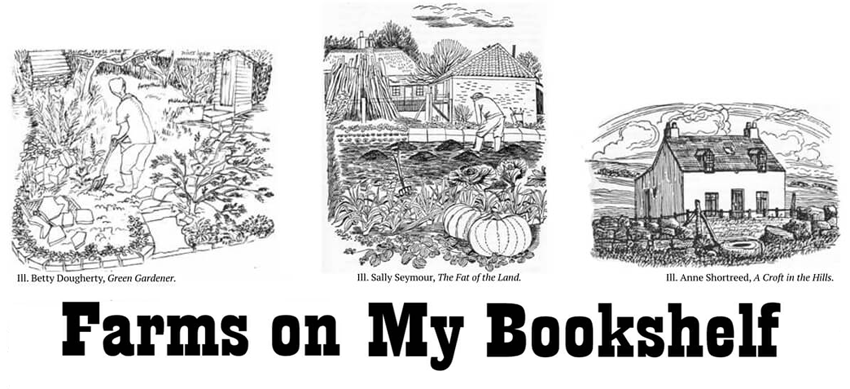Added in september 2023: This is my most popular post. If you are interested in Irene Soper and/or Juliette de Bairacli-Levy don't forget to read all the comments, as people have added interesting information.
Photo's of both cottages, floorplan and map can be found here
I ordered this book knowing just the title. It turned out to
be the story of Irene and her husband Arthur, both artists, who have
lived in the New Forest for about 30 years.
The New Forest is one of
the largest remaining tracts of unenclosed pasture land, heathland and
forest in Southern England, covering southwest Hampshire and southeast
Wiltshire. It was proclaimed a royal forest by William the Conqueror,
featuring in the Domesday Book. It became a National Park in 2006
Irene
and Arthur live in Abbots Well, near Frogham. In their garden is a
small cottage, which used to serve as a home, lastly for herbalist and
writer Juliette de Bairacli-Levy. They do up this cottage (including
re-thatching), which they then use as a studio.
Irene’s garden is surrounded by the forest and is visited by many birds, rabbits, badgers, foxes and stoats.
They
become enthusiastic beekeepers. Irene writes that many people in the
New Forest used to keep bees, and that at one time it was famed for
mead. I knew mead was made with honey, but I had no idea the caps (cut
off the honeycombs) and wild comb (pieces of wax made by bees to fill up
gaps) were used as well.
This is her mead recipe:
Place cappings
and pieces of wild comb in a pan, add enough cold soft water or
rainwater to cover, and bring to the boil. Simmer gently until the wax
rises to the top. Allow to cool. Remove the wax, strain the remaining
liquor into a covered vessel. When luke warm stir in one teaspoonful of
mead yeast and put in a warm place to ferment. When bubbling has ceased,
strain into a cask with air-lock and store for a year before bottling
off.They are also avid badger watchers. First around their
house: Arthur even riggs up an alarm system so they know when a badger
is entering their garden. Later they go out and discover badger setts
and badger watch in the evening. This involves sitting or standing still
for long periods dressed in mosquito proof clothing (wellies, leather
gloves, net veil over the face).
They delight in exploring the surrounding forest.
Standing
on the hill that mooring I realized just how much there was to explore -
the Forest around Abbots Well offered great variety. There was open
moorland with large stretches of furze (or gorse) and heather where many
species of birds were to be seen and which gave cover to several foxes’
earths. There were wooden enclosures where badgers had their setts and
deer grazed peacefuly beneath the shade of the leafy branches.
Peat-stained streams meander their way through wooded glades and open
moorland, here and there opening out to deep pools where small brown
trout would lie. Treacherous bogs were numerous, deceptive in beauty
with bright green moss, colorful flowers and rushes.While searching
for mushrooms they often come across fragments of Roman pottery. In
certain places there is so much that moles throw it up when they dig and
it can be found on top of their mounds.
The New Forest is famous
for its ponies:
Probably the picture which comes to mind at the mention
of the New Forest is that of ponies. They appear on postcards and
calendars and are the subject of very tourist’s snapshot. As they are
running free the give the impression of being wild but each one has an
owner and carries a brand-mark to prove it.Spring is perhaps one
of the best times for the ponies as they can enjoy the sunshine without
the tormenting flies which come with the summer. In spring too the new
foals arrive. It is always interesting to watch the mares leave the
village in the evenings and make their way up Hampton Rudge to the open
Forest where they spend the night, and to see them return again in the
morning with perhaps a new foal born overnight running with them.The
Forest has many products to offer in one way or another:
From olden
times to this day the forester has taken advantage of this and turned
them to good use. Apart from food, rabbits, hares, wild berries and
fungi, which were all available to the peasant, there were materials
such as heather, bracken, timber and peat. Irene ends the
book with tips for making a potpourri of forest finds to capture a tiny
bit of the Forest to last you through the winter, using gorse petals,
golden bracken, seeds, catkins, nuts, lichen, larch cones, pine needles,wood chippings, sloes, rose hips and bark.
I have not been
able to find any information on Irene or Arthur Soper. The publisher (Ex
Libris Press in Bradford on Avon) still exists, so I plan to contact
them. Irene also wrote a cookbook: New Forest Cookery (1983).
Juliette de Bairacli-Levy wrote many books, among them Wanderers of the New Forest (1958).







